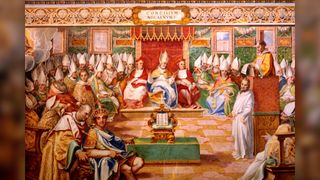Why does Easter change yearly, when dates like Christmas are mounted? The early church grappled with how Easter is set, and the processes for scheduling the holiday weren’t completely set in stone until the sixteenth century. On excessive of that, the dates of Easter utilized by most Western Christian church buildings don’t match how most Jap Christian church buildings resolve the dates for the sacred day.
Inside the early days of Christianity, fully completely different groups of Christians celebrated Easter on fully completely different dates. All agreed that Jesus Christ was crucified and that Easter celebrated his resurrection a few days later. Nevertheless early Christians in Asia Minor (now Turkey) seen the date of his crucifixion on the first day of the Jewish competitors of Passover — “Pesach” in Hebrew — which celebrates the liberation of the Jewish people described inside the biblical E guide of Exodus after they escaped being slaves in Egypt.
In accordance with the Jewish calendar, Passover now begins on 15 Nisan, but it surely certainly was initially celebrated on 14 Nisan, which corresponds to the first full moon of spring. In Christianity, Jesus’ closing supper was a Passover meal that he shared alongside along with his disciples the night sooner than his crucifixion.
Inside the West, nonetheless, early Christians seen the resurrection on the first day of the week following Passover — Easter Sunday — and held that the crucifixion had occurred two days earlier, on Good Friday. All the alternative Easter dates, along with Palm Sunday — the Sunday sooner than Easter that celebrates Jesus’ arrival into Jerusalem — are based totally on Easter’s altering date.
Nevertheless this meant that early Western Christians celebrated Easter on the first Sunday after the 14th day of Nisan, which is likely to be numerous days after early Jap Christians celebrated it.
Related: Why is Christmas celebrated on Dec. 25?
Council of Nicaea

As a result of the church grew stronger, positive disputes, like determining the dates of Easter, turned hotly debated; and in A.D. 325 the First Council of Nicaea tried to resolve them.
This was an assembly of early church leaders who met inside the Jap Roman metropolis of Nicaea (now İznik in western Turkey) in an effort to standardize what Christians believed. (A second Council of Nicaea was held in 787, nevertheless the primary is essential.)
In accordance with Ken Darkisha professor of archaeology and historic previous at King’s School London, the first Council of Nicaea encoded Christian beliefs inside the Nicene Creed, a mannequin of which continues to be recited in Catholic and Orthodox church corporations proper now.
The council moreover tried to resolve the disputes in regards to the dates of Easter nevertheless with comparatively a lot much less success; a dispute between Roman and Celtic clergy in early England over the dates for Easter wasn’t resolved until 664, in favor of the Western and Roman approach.
“From the second century onwards, the calculation of the date of Easter was a difficulty inside the early church,” Darkish instructed Reside Science. “Although the Council of Nicaea in 325 tried to resolve this, the matter proved controversial for a whole lot of years.”
Spring equinox
Along with standardizing the dates of Easter, the Council of Nicaea wanted to maneuver its calculation away from the Jewish calendar, which was by that time seen as a relic from a particular religion.
The council’s decision was to tie its calculation to the vernal or spring equinoxwhich occurs yearly on March 20 or March 21.
The strategy determined by the Council of Nicaea continues for use proper now: Easter Sunday must be seen on the first Sunday after the first full moon after the spring equinox — which now means Easter falls on any Sunday between March 22 and April 25.
The an identical technique is utilized by the Catholic Church (and most Protestant church buildings) and the Jap Orthodox church buildings, nevertheless with the excellence that these now use fully completely different calendars: The Catholic Church and most Protestants use the Gregorian calendar, a reform launched by Pope Gregory XIII in 1582, nevertheless the Orthodox church buildings nonetheless use the Julian calendar, which was launched by Julius Caesar in 46 B.C.
The result is that fully completely different dates for Easter are seen in quite a few elements of the world, whatever the whole efforts to standardize them.
Related: How so much does the soul weigh?
No pagans
The Christian Easter celebration is often acknowledged to have pagan origins and use pagan symbolism just like eggs and rabbitsnevertheless historians usually don’t suppose it has pagan hyperlinks.
“Inside the Germanic lands it may properly have taken on attributes from a pagan spring competitors, nevertheless we now have little or no proof for that,” Ronald Huttona professor of historic previous on the Faculty of Bristol inside the U.Okay., instructed Reside Science in an e mail.
Hutton well-known that the eighth-century Anglo-Saxon scholar Bede wrote that his ancestors had named the month of April after the pagan goddess Eostre; and some suppose that’s the origin of the time interval Easter. Nevertheless Bede’s remark is the one proof for the declare, and Easter could occur in March.
Within the meantime, “every Easter and Eostre would possibly want been named from a root phrase signifying dawning or opening or spring, cognate to the Greek Eos,” Hutton acknowledged. “Positively there seems to be no trace of an historic pagan competitors in northern Europe that fell between mid-March and mid-April.”
